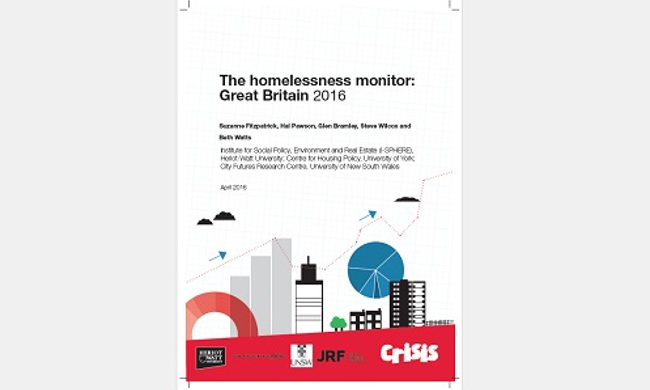The Homelessness Monitor: Great Britain 2016
26.04.2016
The Homelessness Monitor: Great Britain 2016 is the second annual report of an independent study, funded by Crisis and the Joseph Rowntree Foundation, of the homelessness impacts of recent economic and policy developments in England.
Key findings
- Over the past five years there has been a growing variation in the levels and patterns of homelessness across England, Wales and Scotland. Statutory homelessness policy has diverged significantly across Great Britain since devolution in 1999 and is a contributing factor in explaining these differences.
- Since the Homelessness Monitors have been conducted in 2011, most key informants have maintained that policy factors – and in particular welfare reform – have a far more profound impact on homelessness trends than the economic context in and of itself. This is apparent by the divergence in levels and patterns of homelessness across the devolved nations.
- In England, rough sleeping is on a sharp upward trajectory with the national total having doubled between 2010 and 2015. At 30%, the 2015 country-wide increase was the largest to date. Over the past two years, however, the national statutory homelessness caseload has largely stabilised. In 2014/15 the total number of decisions remained static, albeit at 26 per cent above the 2009/10 level. However, administrative changes mean that these official statistics understate the true increase in ‘homelessness expressed demand’ over recent years.
- In contrast, in Scotland the total number of applications has fallen by 37% since 2009/10. In the most recent year, total applications fell by 4% while ‘assessed as homeless’ cases dropped by 5%. This downward trend is wholly the result of the introduction of the ‘Housing Options’ model of homelessness prevention from 2010 onwards.
- A downward trend in homelessness ‘acceptances’ has been evident in Wales since 2011/12. By 2014/15, the total had fallen back to a level 8% below that of the previous nadir in 2009/10. Similarly, the last year has seen an 11% drop in total homelessness assessment decisions by Welsh local authorities, with the 2014/15 figure thus reduced almost to the 2009/10 low. Despite their recent decline, recorded statutory homelessness acceptances in Wales (prior to the new homelessness legislation) were 70% higher than in England, pro rata to population.
- The Housing (Wales) Act 2014 ushered in significant changes to the homelessness legislation in Wales, which has seen a far stronger emphasis placed on prevention and relief duties owed to all eligible homeless households/households threatened with homelessness, regardless of priority need.
- Scotland abolished the priority need criterion at end of 2012, but policy debate and development on homelessness continues. The most important innovation over recent years has been the promotion of the ‘Housing Options’ approach to homelessness prevention in Scotland, with the Scottish Government providing (relatively modest) financial support for the establishment of five regional ‘Housing Options Hubs’ in 2010
- Threatening to overwhelm efforts to prevent and address homelessness across the whole of the UK is the ongoing impact of welfare reform. A further round of major welfare reforms and cuts were announced in the 2015 Summer Budget, which will have particular implications for young single people under 22 years old and for larger families, and more generally for the ability of low income households to access the private rented sector.
Reference
Fitzpatrick, S., Pawson, H., Bramley, G., Wilcox, S. & Watts, B. (2016) The Homelessness Monitor: Great Britain 2016, London: Crisis.

